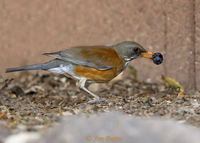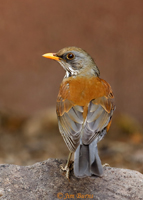Here are the dates, with brief notes explaining the growing illumination.
November 6—Biden defeats Trump
January 6—The Constitution defeats Trump’s deplorables
January 13—Our first new yard bird of the calendar year appears
January 19—My first Pfizer dose
February 2—Deva’s first Pfizer dose
February 8—My second Pfizer dose
February 23—Deva’s second Pfizer dose
I’m guessing if you’re a human being with a brain and any empathy for your fellow man, only the January 13 entry warrants an explanation. It was a typical mid-winter Arizona morning, a Wednesday, bright sun in its cloudless blue vault having just burned off the desert’s overnight chill. I was making lunch at the sink by our kitchen window which looks out onto the front yard. A flock of Gambel’s Quail, many of them young from the previous spring, were picking at the fruit littering the desert landscaping beneath the Russian Olive tree. Then I noticed a robin scamper across the yard and pluck an olive off the sidewalk right beneath the window.
Every now and then in a birder’s life a completely unexpected and inexplicable observation triggers so many simultaneous yet disparate thoughts that the crucial one is buried, a nugget of OMG beneath the debris of totally irrelevant considerations. Here’s how those went down that Wednesday morning.
How about that, we’ve never had a robin in our yard?
Hmm, I wouldn’t have guessed robins would eat olives?
Well, it’s winter in the desert, probably no worms under our xeriscape?
Oh yeah, robin would be a new yard bird, wouldn’t it?
Very bright for a robin, kind of thin, moves fast?
Look at that cool orange eye ring?
Wait, what!?!
For sure, non-birders don’t even realize robins have first names, American across all of North America, but Clay-coloreds are established now in south Texas and we get Rufous-backed in Arizona in winter. And, OMG, here in our front yard was a robin that was not an American Robin! This train of thought actually took only a couple nanoseconds. I ran for the camera but, when I got back, it was gone. Okay, when I tell Deva about this, why would she believe it if I don’t even believe it myself?
It has been an “invasion” year for Rufous-backeds in Arizona. There has been one in the Hassayampa Preserve an hour east of Phoenix, a report of one from Green Valley, one along Blue Heaven Road, and six seen in a flock along the Santa Cruz River. A winter “flock” of Rufous-backed Robins in Arizona boggles the birder’s brain. Many years there are none, some years two or three may be reported briefly from widely scattered locations in southern Arizona, often none of these “chaseable,” and the species is unheard of in residential settings. Actually my birding mentor, Pat Beall, had one in her Ahwatukee yard many years ago and called to tell me, but it was never seen again.
As I write this column on February 21 our special guest is still here. I have pictures, proof now of course, and most days we see him at least once. Because the bird is so bright, I’ve assumed it is a male, and I’m chalking his presence up to global warming. Oh, right--“climate change” since Texas suffered through a week of single digit temperatures. His visits are very brief, in and out for a bite of olive and a quick drink at the drip in the backyard.
The chances of this rare visitor from south of the border appearing in the yard of avid birders, and staying this long, are vanishingly small. Basically we’ve won the birding lottery, and why is just a rhetorical question. But there are several noteworthy things related to his sojourn here. Our property is small, other residences all around. The neighborhood is not verdant, but we are two blocks from the Scottsdale Greenbelt. We have two water sources, three olive trees, several large flowering bushes, and we put out suet and seed in the winter. Our best previous yard bird was a one morning wonder Gray Catbird in the fall fourteen years ago. Nothing else comes close, and I’m sure nothing else ever will.
There are other interesting questions. The only pattern we’ve discerned in his behavior is that there is no pattern. If I hadn’t seen him for five seconds that first morning, we may never have seen him, so brief and sporadic are his appearances. But now that we watch for him, we’ve seen him at first light, in the evening when it’s too dark to photograph, and at almost every hour in between. Was that propitious first sighting his first day here? We’ve never seen him again in the front, always in the back. Where does he spend the rest of his day? Why is he so skittish when there are many semi-tame birds around all day? Or is he shy because they are species he may not encounter in his breeding habitat?
As with all things avian, the mysteries begin to outweigh the givens. I would love to capture him and pluck a feather to wear as an amulet until the pandemic resolves into normality. At any rate, the color orange has been rehabilitated, for us at least. From a derisive cartoon meme throughout a long dark tunnel, orange has now morphed into a bright, wonderful memory reminding us that every tunnel has a light at the end. |
 |
 |